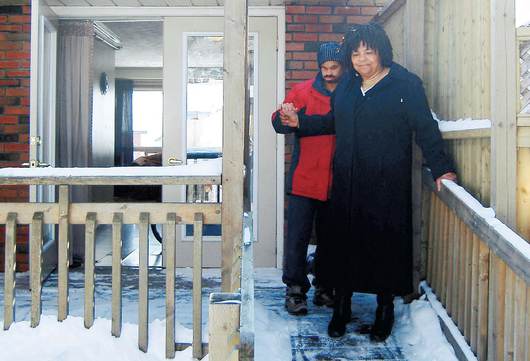Homes for Deafblind Adults Designed to be “Senseable”

When you “ring” the doorbell to Stephen’s apartment, his pager vibrates. If an alarm goes off, his bed vibrates. Thanks to these “senseable” gadgets and designs, Stephen, who is deafblind, is able to live more independently.
Designing a home for someone who has hearing and vision disabilities presents unique challenges. A team leader of Independent Living Residences for the DeafBlind Ontario (ILRDBO), Tracey Veldhuis helps deafblind residents create comfortable, safe living environments. The biggest challenge is that solutions that traditionally help someone who is blind may not work for someone who is also deaf, and vice versa.
“One of the toughest things has been finding a kettle that makes it easy for someone who is both deaf and blind to know that the water has been boiled,” says Veldhuis. “If you’re blind, you can’t see the steam, and if you’re deaf, you can’t hear the whistle. We’ve created a makeshift solution where the resident sets a timer and holds it so it vibrates when the kettle should go off.”
There are many “common sense” solutions that enable deafblind individuals to increase their level of independence. Veldhuis says the floor plan, paint colours and markings can help a deafblind individual feel more at home. “Choosing colours with high contrast helps residents manage their surroundings more independently,” says Veldhuis. “If you have two walls in a hallway that meet at a corner, a contrasting paint colour can help make it more visible. Door jambs can also be painted in high-contrast colours so they stand out and aren’t walked into.”
Flooring can indicate location. “The lip between a carpeted living room and linoleum kitchen creates an instant point of reference,” says Veldhuis. “An area rug identifies a sink or other appliances.”
Textured stickers, tape or paint can mark dials and buttons for appliances including stoves, dishwashers and washing machines. Setting the hot water tank to a maximum temperature helps protect against burns. Safety features such as bars reduce the risk of falls and serve as guide rails.
Technology such as CCTV (closed circuit television), TTY (text telephone) and magnification devices open up more opportunities. Computers with accessibility features such as black-and-white monitor backgrounds and large keys help some deafblind adults connect with friends. “Stephen uses programs like MSN Messenger and web cameras with modified screen settings to communicate with his network and even order supplies he may need,” says Veldhuis.
Because some residents use wheelchairs, doorways and hallways need to be wider. Extra space underneath a countertop accommodates a wheelchair and enables a deafblind resident to better participate in food preparation.
The design of the home outside can also play a large role in increasing a deafblind individual’s level of independence. This includes the location within the community – in particular, striking a balance between a place that is accessible and close to amenities, but not on a busy street. “Some sort of marker, like a bush or post at the sidewalk, can help people identify their home,” says Veldhuis. Bright paint can make a garage or front door easier to identify. Planters and sidewalks help the resident know where they are in the yard.
No detail is overlooked in the planning of ILRDBO homes, and Veldhuis says the effort pays off. “You’d be surprised at how many of these small things can make a big difference in making a deafblind individual feel more independent on their terms.”
Roxanna Spruyt-Rocks is executive director of Independent Living Residences for the DeafBlind in Ontario (www.ilrdbo.ca), a not-for-profit organization that creates safe and comfortable environments that enable deafblind individuals in the province to live more independently. ILRDBO currently provides 32 deafblind adults with community-based housing, trained intervention support, independent living skills, work experience and social programs.














